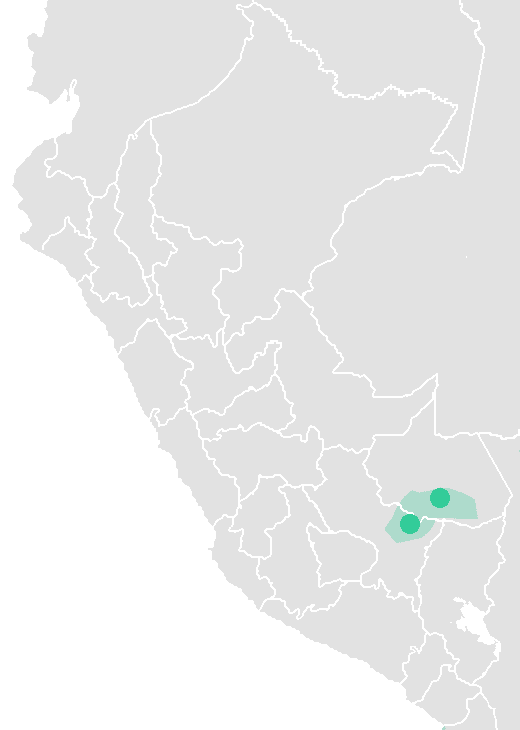|
Macro-Arawakan Languages
Macro-Arawakan is a proposed language family of South America and the Caribbean centered on the Arawakan languages. Sometimes, the proposal is called Arawakan, and the central family is called ''Maipurean''. Proposals Kaufman (1990) includes the following: **Arawakan (Maipurean) ** Arawan ** Guajiboan **Candoshi Payne (1991) and Derbyshire (1992) have: **Arawakan (Maipurean) ** Arawan ** Guajiboan ** Puquina ** Harakmbet Jolkesky (2016) argues for the following: **Arawakan (Maipurean) **Candoshi ** Puquina ** Munichi According to Jolkesky (op. cit., 611-616), the proto-Macro-Arawakan language would have been spoken in the Middle Ucayali River Basin during the beginning of the 2nd millennium BCE, and its speakers would have produced Tutishcainyo pottery in the region. Martins (2005: 342–370) groups the Arawakan and Nadahup languages The Nadahup languages, also known as Makú (Macú) or ''Vaupés–Japurá'', form a small language family in Brazil, Colombia, and V ... [...More Info...] [...Related Items...] OR: [Wikipedia] [Google] [Baidu] |
Latin America
Latin America is the cultural region of the Americas where Romance languages are predominantly spoken, primarily Spanish language, Spanish and Portuguese language, Portuguese. Latin America is defined according to cultural identity, not geography, and as such it includes countries in both North and South America. Most countries south of the United States tend to be included: Mexico and the countries of Central America, South America and the Caribbean. Commonly, it refers to Hispanic America plus Brazil. Related terms are the narrower Hispanic America, which exclusively refers to Spanish-speaking nations, and the broader Ibero-America, which includes all Iberic countries in the Americas and occasionally European countries like Spain, Portugal and Andorra. Despite being in the same geographical region, English- and Dutch language, Dutch-speaking countries and territories are excluded (Suriname, Guyana, the Falkland Islands, Jamaica, Trinidad and Tobago, Belize, etc.), and French- ... [...More Info...] [...Related Items...] OR: [Wikipedia] [Google] [Baidu] |
Puquina Language
Puquina (or Pukina) is an extinct language once spoken by a native ethnic group in the region surrounding Lake Titicaca (Peru and Bolivia) and in the north of Chile. It is often associated with the culture that built Tiwanaku. Remnants of Puquina can be found in the Quechuan and Spanish languages spoken in the south of Peru, mainly in Arequipa, Moquegua and Tacna, as well as in Bolivia. There also seem to be remnants in the Kallawaya language, which may be a mixed language formed from Quechuan languages and Puquina. (Terrence Kaufman (1990) finds the proposal plausible.) Some theories claim that "Qhapaq Simi", the cryptic language of the nobility of the Inca Empire, was closely related to Puquina, and that ''Runa Simi'' (Quechuan languages) were spoken by commoners. Moulian ''et al.'' (2015) argue that Puquina language influenced Mapuche language of southern Chile long before the rise of the Inca Empire. This areal linguistic influence may have started with a migratory wave ... [...More Info...] [...Related Items...] OR: [Wikipedia] [Google] [Baidu] |
Daniel Garrison Brinton
Daniel Garrison Brinton (May 13, 1837July 31, 1899) was an American archaeologist, ethnologist, historian, and surgeon. Biography Brinton was born in Thornbury Township, Chester County, Pennsylvania. After graduating from Yale University in 1858, Brinton studied at Jefferson Medical College for two years and spent the next year traveling in Europe. He continued his studies at Paris and Heidelberg. From 1862 to 1865, during the American Civil War, he was a surgeon in the Union army, acting during 1864–1865 as surgeon-in-charge of the U.S. Army general hospital at Quincy, Illinois. Brinton was sun-stroked at Missionary Ridge ( Third Battle of Chattanooga) and was never again able to travel in very hot weathers. This handicap affected his career as an ethnologist. After the war, Brinton practiced medicine in West Chester, Pennsylvania for several years; was the editor of a weekly periodical, the Medical and Surgical Reporter, in Philadelphia from 1874 to 1887; became professor ... [...More Info...] [...Related Items...] OR: [Wikipedia] [Google] [Baidu] |
Aguachile Language
Lapachu, also known as Apolista or Aguachile, is an extinct Arawakan language of Bolivia. Aikhenvald (1999) classifies it together with Terena The Trans-European Research and Education Networking Association (TERENA, ) was a not-for-profit association of European national research and education networks (NRENs) incorporated in Amsterdam, The Netherlands. The association was originally ..., Moxos, and related languages. It is not clear from surviving descriptions whether it was one language or two. References Arawakan languages {{Arawakan-lang-stub pms:Lenga enawené-nawé Languages of Bolivia ... [...More Info...] [...Related Items...] OR: [Wikipedia] [Google] [Baidu] |
Moscow School Of Comparative Linguistics
The Moscow School of Comparative Linguistics (also called the Nostratic languages, Nostratic School) is a school of linguistics based in Moscow, Russia that is known for its work in . Formerly based at Moscow State University, it is currently centered at the (Institute of Linguistics of the Russian State University for the Humanities), and also the Institute of Linguistics of the Russian Academy of Sciences in Moscow, Russia. History The founders of the school are Vladislav Illich-Svitych and Aharon Dolgopolsky.Stachowski, Marek. Teoria nostratyczna i szkoła moskiewska (польск.) // LingVaria / Redaktor naczelny Mirosław Skarżyński. — Kraków: Wydawnictwo „Księgarnia Akademicka”, 2011. — T. VI, nr 1 (11). — S. 241—274. — ISSN 1896-2122.Старостин Г. С. и др. К истокам языкового разнообразия. Десять бесед о сравнительно-историческом языкознании с Е. Я. Сатанов� ... [...More Info...] [...Related Items...] OR: [Wikipedia] [Google] [Baidu] |
Purus River
The Purus River (Portuguese: ''Rio Purus''; Spanish: ''Río Purús'') is a tributary of the Amazon River in South America. Its drainage basin is , and the mean annual discharge is . The river shares its name with the Alto Purús National Park and the Purús Province (and its conformed Purús District), one of the four provinces of Peru in the Ucayali Region. Geography The Purus River rises in Peru. It defines the boundary between Peru and Brazil in the centre of the state of Acre, then runs for a short distance along the boundary of the Santa Rosa do Purus National Forest, a sustainable use conservation unit created in 2001 after it is joined by the Santa Rosa River. The Purus then flows north east through Manoel Urbano It runs through a continuous forest at the bottom of the great depression, lying between the Madeira River, which skirts the edge of the Brazilian sandstone plateau, and the Ucayali River, which hugs the base of the Andes. In the state of Amazonas the r ... [...More Info...] [...Related Items...] OR: [Wikipedia] [Google] [Baidu] |
Juruá River
The Juruá River ( ; ) is a southern affluent river of the Amazon River west of the Purus River. The Juruá emerges from highlands in east-central Peru, then winds its way through lowlands in Brazil, sharing with this the bottom of the immense inland Amazon depression; and having all the characteristics of the Purus as regards curvature, sluggishness and general features of the low, half-flooded forest country it traverses. For most of its length, the river flows through the Purus várzea ecoregion. This is surrounded by the Juruá-Purus moist forests ecoregion. The Juruá rises among the Ucayali highlands, and is navigable and unobstructed for a distance of above its junction with the Amazon. It has a total length of approximately , and is one of the longest tributaries of the Amazon. The Médio Juruá Extractive Reserve, created in 1997, is on the left bank of the river as it meanders in a generally northeast direction through the municipality of Carauari. The lower Jur ... [...More Info...] [...Related Items...] OR: [Wikipedia] [Google] [Baidu] |
Nadahup Languages
The Nadahup languages, also known as Makú (Macú) or ''Vaupés–Japurá'', form a small language family in Brazil, Colombia, and Venezuela. The name ''Maku people (other), Makú'' is pejorative, being derived from an Arawakan languages, Arawakan word meaning "without speech". ''Nadahup'' is an acronym of the constituent languages. The Nadahup family should not be confused with several other languages which go by the name ''Maku language, Makú''. There are proposals linking this unclassified language with Nadahup, but also with other languages. External relationships Martins (2005: 342–370) groups the Arawakan languages, Arawakan and Nadahup languages together as part of a proposed Makúan-Arawakan (Nadahup-Arawakan) family, but this proposal has been rejected by Aikhenvald (2006: 237). Epps and Bolaños (2017) accept the unity of the four Nadahup languages, but do not consider Puinave language, Puinave to be related. Language contact Jolkesky (2016) notes that th ... [...More Info...] [...Related Items...] OR: [Wikipedia] [Google] [Baidu] |
Ucayali River
The Ucayali River (, ) is the main headstream of the Amazon River. It rises about north of Lake Titicaca, in the Arequipa region of Peru and becomes the Amazon at the confluence of the Marañón river, Marañón close to Nauta city. The city of Pucallpa is located on the banks of the Ucayali. Description The Ucayali, together with the Apurímac River, the Ene River and the Tambo River (Peru), Tambo River, is today considered the Source of the Amazon River, main headwater of the ''Amazon River'', totaling a length of from the source of the ''Apurímac'' at Nevado Mismi to the confluence of the Ucayali and Marañón Rivers: *Apurímac River (total length): *Ene River (total length): *Tambo River (total length): * Ucayali River (confluence with Tambo River to confluence with the Marañón): Exploration The Ucayali was first called ''San Miguel'', then ''Ucayali'', ''Ucayare'', ''Poro'', ''Apu-Poro'', ''Cocama'' and ''Rio de Cuzco''. Peru has organised many costly and ably-con ... [...More Info...] [...Related Items...] OR: [Wikipedia] [Google] [Baidu] |
Harakmbet Languages
The Harakmbut (Arakmbut, Harakmbet) are indigenous people in Peru. They speak the Harakmbut language. An estimated 2,000 Harakmbut people live in the Madre de Dios Region near the Brazilian border in the Peruvian Amazon."Peru: Indigenous Harakmbut Suffer Effects Of Climate Change." ''Indigenous Peoples Issues and Resources.'' (retrieved 20 Feb 2011) Amarakaeri  Amarakaeri are also called Amaracaire or Amarakaire people. S ...
Amarakaeri are also called Amaracaire or Amarakaire people. S ...
[...More Info...] [...Related Items...] OR: [Wikipedia] [Google] [Baidu] |
Candoshi Language
Candoshi-Shapra (also known as Candoshi, Candoxi, Kandoshi, Kandozi-Chapra, and Murato) is an indigenous American language isolate, spoken by several thousand people in western South America along the Chapuli, Huitoyacu, Pastaza, and Morona river valleys. There are two dialects, Chapara (also spelled Shapra) and Kandoashi (Kandozi). It is an official language of Peru, like other native languages in the areas in which they are spoken and are the predominant language in use. Around 88.5 percent of the speakers are bilingual with Spanish. The literacy rate in Candoshi-Shapra is 10 to 30 percent and 15 to 25 percent in the second language Spanish. There is a Candoshi-Shapra dictionary, and grammar rules have been codified. Distribution Kandozi is spoken to the southeast of the main Chapra area. It is spoken along the Chapuli River (or Chapuri River) and sources of Rimachi Lake, the Huitoyacu River, and other tributaries of the Pastaza River. Chapra is spoken along the Pushaga R ... [...More Info...] [...Related Items...] OR: [Wikipedia] [Google] [Baidu] |



